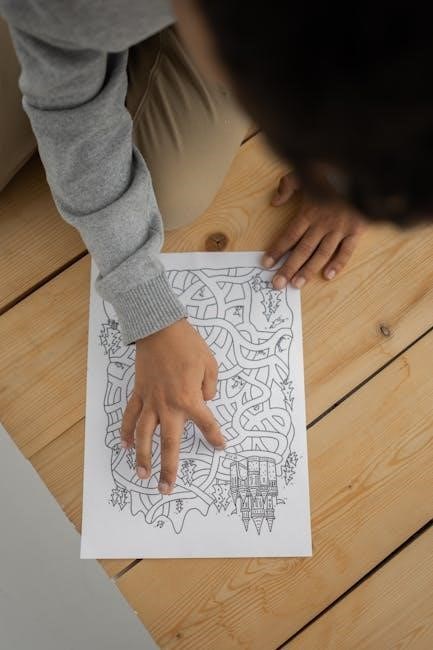Congruent triangles are identical in shape and size, with corresponding sides and angles equal․ They are fundamental in geometry, enabling comparisons and solving problems through precise properties․
1․1 Definition of Congruent Triangles
Congruent triangles are identical in shape and size, with all corresponding sides and angles equal․ When two triangles are congruent, one can be moved (via translation, rotation, or reflection) to perfectly overlap the other․ This means every side and angle in one triangle matches exactly with its counterpart in the other triangle․ The criteria for determining congruence include Side-Side-Side (SSS), Side-Angle-Side (SAS), and Angle-Side-Angle (ASA) rules․ Understanding these definitions is crucial for solving geometric problems and proving theorems․ Congruent triangles are fundamental in geometry and real-world applications․
1․2 Importance of Studying Congruent Triangles
Studying congruent triangles is essential for developing geometric reasoning skills․ They form the basis for understanding various theorems and properties, such as CPCTC, which states that corresponding parts of congruent triangles are equal․ This knowledge is crucial in solving problems involving triangle congruence and similarity․ It also has practical applications in fields like architecture, engineering, and construction, where precise measurements and identical structures are required․ Mastery of congruent triangles enhances spatial awareness and logical thinking, making it a foundational concept in geometry education․

Methods to Prove Triangle Congruence
Several methods exist to prove triangle congruence, including SSS, SAS, ASA, AAS, and HL for right triangles, essential for establishing equality in geometric problems․
2․1 Side-Side-Side (SSS) Congruence Rule
The Side-Side-Side (SSS) rule states that if three sides of one triangle are equal to three sides of another triangle, the triangles are congruent․ This method is reliable because it ensures all corresponding parts are identical․ In worksheets, identifying equal sides helps apply the SSS rule effectively․ For example, if triangle ABC has sides AB=5cm, BC=7cm, and AC=9cm, and triangle DEF has sides DE=5cm, EF=7cm, and DF=9cm, then triangles ABC and DEF are congruent by SSS․
2․2 Side-Angle-Side (SAS) Congruence Rule
The Side-Angle-Side (SAS) rule confirms congruence if two sides and the included angle of one triangle are equal to those of another․ This rule applies when the angle is between the two sides, ensuring precise alignment․ Worksheets often highlight this method, emphasizing the need to verify the included angle․ For instance, if triangle ABC has AB=6cm, BC=8cm, and angle B=50°, and triangle DEF has DE=6cm, EF=8cm, and angle E=50°, then triangles ABC and DEF are congruent by SAS․
2․3 Angle-Side-Angle (ASA) Congruence Rule
The Angle-Side-Angle (ASA) rule states that two triangles are congruent if two angles and the included side of one triangle are equal to those of another․ This method is particularly useful when two angles are known, as the third can be calculated using the angle sum property․ Worksheets often include problems where students apply ASA to verify congruence, ensuring accuracy in identifying corresponding parts of triangles․
2․4 Angle-Angle-Side (AAS) Congruence Rule

The Angle-Angle-Side (AAS) rule is a method to prove triangle congruence․ It states that if two angles and a non-included side of one triangle are equal to those of another triangle, the triangles are congruent․ This rule relies on the fact that two equal angles determine the third angle due to the angle sum theorem․ Worksheets often include problems where students apply AAS to verify congruence, ensuring they understand how angles and sides correspond in identical triangles․
2․5 Hypotenuse-Leg (HL) Congruence Rule for Right Triangles
The Hypotenuse-Leg (HL) rule is specific to right-angled triangles․ It states that if the hypotenuse and one leg of a right triangle are congruent to the hypotenuse and corresponding leg of another right triangle, the triangles are congruent․ This rule is a special case of triangle congruence, ensuring that the right angle and the two sides provide sufficient information to establish congruence․ Worksheets often include right triangles for students to apply the HL rule, reinforcing its application in geometric proofs and problems․

Identifying Congruent Triangles
Congruent triangles are identified by comparing corresponding sides and angles using rules like SAS, ASA, SSS, and AAS․ Matching parts confirm congruence through precise geometric criteria․
3․1 Matching Corresponding Parts
Matching corresponding parts is crucial in identifying congruent triangles․ Corresponding sides and angles must be equal in measure, ensuring triangles are identical in shape and size․
Worksheets often provide triangle pairs with labeled sides and angles, requiring students to verify congruence by matching these parts according to established rules like SAS or SSS․
3․2 Using Triangle Congruence Theorems
Triangle congruence theorems, such as SAS, SSS, ASA, and AAS, provide structured methods to prove triangles are congruent․ These theorems rely on corresponding parts being equal, ensuring identical shapes․ Worksheets often include exercises where students apply these theorems to verify congruence, promoting problem-solving skills and geometric understanding․ By mastering these theorems, learners can confidently determine if triangles are congruent, a foundational skill in geometry and real-world applications like construction and engineering․

Solving Problems Using Triangle Congruence
Solving problems using triangle congruence involves applying SSS, SAS, ASA, and AAS rules to determine if triangles are identical in shape and size, aiding real-world applications․
4․1 Determining Congruence in Given Triangles
Determining congruence in triangles involves analyzing corresponding sides and angles․ Using rules like SSS, SAS, ASA, and AAS, one can verify if triangles are identical․ For example, in ΔDEF, applying SAS congruence helps compare sides DE and EF with another triangle․ By matching corresponding parts, one can conclude if triangles are congruent․ This process is essential for solving geometric problems and real-world applications, ensuring accuracy in constructions and designs․
4․2 Applying Congruence Rules to Real-World Scenarios
Congruent triangles are essential in architecture, engineering, and design․ Architects use SAS and ASA rules to ensure structural stability and symmetry in buildings․ Engineers apply AAS and SSS congruence to design precision machinery․ In construction, congruent triangles help in creating identical roof trusses or bridge frameworks․ These principles ensure safety and functionality, making them indispensable in real-world applications․ Understanding congruence rules enables professionals to solve practical problems efficiently, ensuring accuracy and reliability in their work․ This knowledge is vital for creating durable and functional structures in various industries․

Properties of Congruent Triangles
Congruent triangles have identical corresponding parts, ensuring equal sides, angles, and vertices․ This property, known as CPCTC, is crucial for proving geometric theorems and solving problems accurately․
5․1 Corresponding Parts of Congruent Triangles (CPCTC)
Corresponding parts of congruent triangles are equal, a principle known as CPCTC․ This means that if two triangles are congruent, their corresponding sides, angles, and vertices are identical in measure; This fundamental property is essential for solving geometric problems, as it allows the transfer of measurements between triangles․ Worksheets often include exercises where students identify and apply CPCTC to prove congruence or find missing lengths and angles, reinforcing the concept through practical application․
5․2 Using CPCTC to Prove Geometric Theorems
CPCTC is a cornerstone for proving various geometric theorems, enabling the establishment of equal lengths, angles, and segments․ By leveraging the correspondence between congruent triangles, mathematicians can deduce properties of polygons, circles, and other shapes․ Worksheets often feature exercises where students apply CPCTC to validate theorems, such as the median or angle bisector theorem, reinforcing their understanding of geometric principles through hands-on problem-solving․

Real-World Applications of Congruent Triangles
Congruent triangles are essential in architecture, engineering, and design, ensuring structural integrity and symmetry․ They are also used in puzzle solving and crafting identical shapes for precise measurements․
6․1 Architecture and Construction
Congruent triangles play a crucial role in architecture and construction, ensuring symmetry and balance in designs․ They are used to create identical structural elements, such as beams and arches, guaranteeing stability and durability․ Architects rely on these triangles to draft precise blueprints, while construction teams use them to replicate identical features in buildings, bridges, and monuments․ The precision offered by congruent triangles helps achieve aesthetic appeal and functional integrity, making them indispensable in modern and historical structures alike․
6․2 Engineering and Design
Congruent triangles are essential in engineering and design, ensuring precision and symmetry in creating uniform structures and mechanisms․ Engineers use them to design identical components, such as gears, bridges, and electronic circuits, where exact measurements are critical․ In product design, congruent triangles help achieve aesthetic symmetry and functional efficiency․ Their application in CAD software and 3D modeling further highlights their importance in modern engineering practices, enabling the creation of reliable and visually appealing designs that meet precise specifications․

Creating Effective Congruent Triangles Worksheets
Effective worksheets should include clear instructions, diagrams, and varied problems to engage students․ Incorporate step-by-step solutions and interactive elements to enhance learning and understanding of congruence rules․
7․1 Designing Clear and Concise Problems
When designing problems for congruent triangles worksheets, focus on clarity and precision․ Use labeled diagrams to illustrate triangle pairs, ensuring sides and angles are clearly marked․ Begin with basic problems using SAS, ASA, or SSS rules, gradually increasing complexity․ Include multiple-choice and fill-in-the-blank questions to cater to different learning styles․ Provide step-by-step solutions for each problem to guide students․ Incorporate real-world scenarios to make concepts relatable․ Ensure each problem builds on previous knowledge, fostering a logical progression in understanding triangle congruence․
7․2 Incorporating Visual Aids and Diagrams
Visual aids are essential for teaching congruent triangles․ Include clear, labeled diagrams in your worksheet to illustrate triangle pairs․ Use distinct colors or shading to highlight corresponding sides and angles․ Add coordinate geometry exercises where students plot triangles to observe congruence․ Incorporate transformation diagrams showing translations, rotations, and reflections․ Ensure diagrams are accurate and scaled appropriately․ Interactive elements, like matching games, can enhance engagement․ Visual aids help students connect theoretical concepts with practical applications, making learning more intuitive and effective in understanding congruence principles․

Solving Congruent Triangles Exercises
Solving congruent triangles exercises involves applying SAS, ASA, or AAS criteria․ Start with basic problems, then progress to complex scenarios involving real-world applications like architecture and engineering․
8․1 Step-by-Step Approach to Solving Problems
To solve congruent triangle problems, start by identifying given sides and angles․ Use SAS, ASA, or AAS criteria to determine congruence․ Mark corresponding parts clearly․ Verify measurements and angle relationships․ Apply CPCTC to prove additional properties․ Check for accuracy in calculations and logical reasoning․ Practice with sample worksheets to refine skills․ Review common mistakes to ensure understanding․ Use diagrams to visualize triangle relationships and confirm congruence․
8․2 Common Mistakes to Avoid
When solving congruent triangle problems, common errors include misidentifying corresponding parts and incorrectly applying congruence rules․ Ensure accurate correspondence of sides and angles, and avoid rushing through problems․ Properly label diagrams to prevent confusion․ Misapplying CPCTC and neglecting to verify measurements are frequent oversights․ Stay organized, manage time effectively, and double-check work to minimize mistakes․ Careful attention to detail and methodical application of theorems will enhance accuracy and understanding in solving congruent triangle problems․
Congruent triangles are a cornerstone of geometry, essential for understanding shape comparison and problem-solving․ Worksheets on this topic provide practical exercises to master concepts like SSS, SAS, ASA, and AAS rules․ Real-world applications in architecture and engineering highlight their relevance․ By avoiding common mistakes and applying theorems accurately, learners can deepen their grasp of congruent triangles․ Regular practice with worksheets ensures proficiency and confidence in tackling geometric challenges, reinforcing foundational skills for advanced mathematics․

